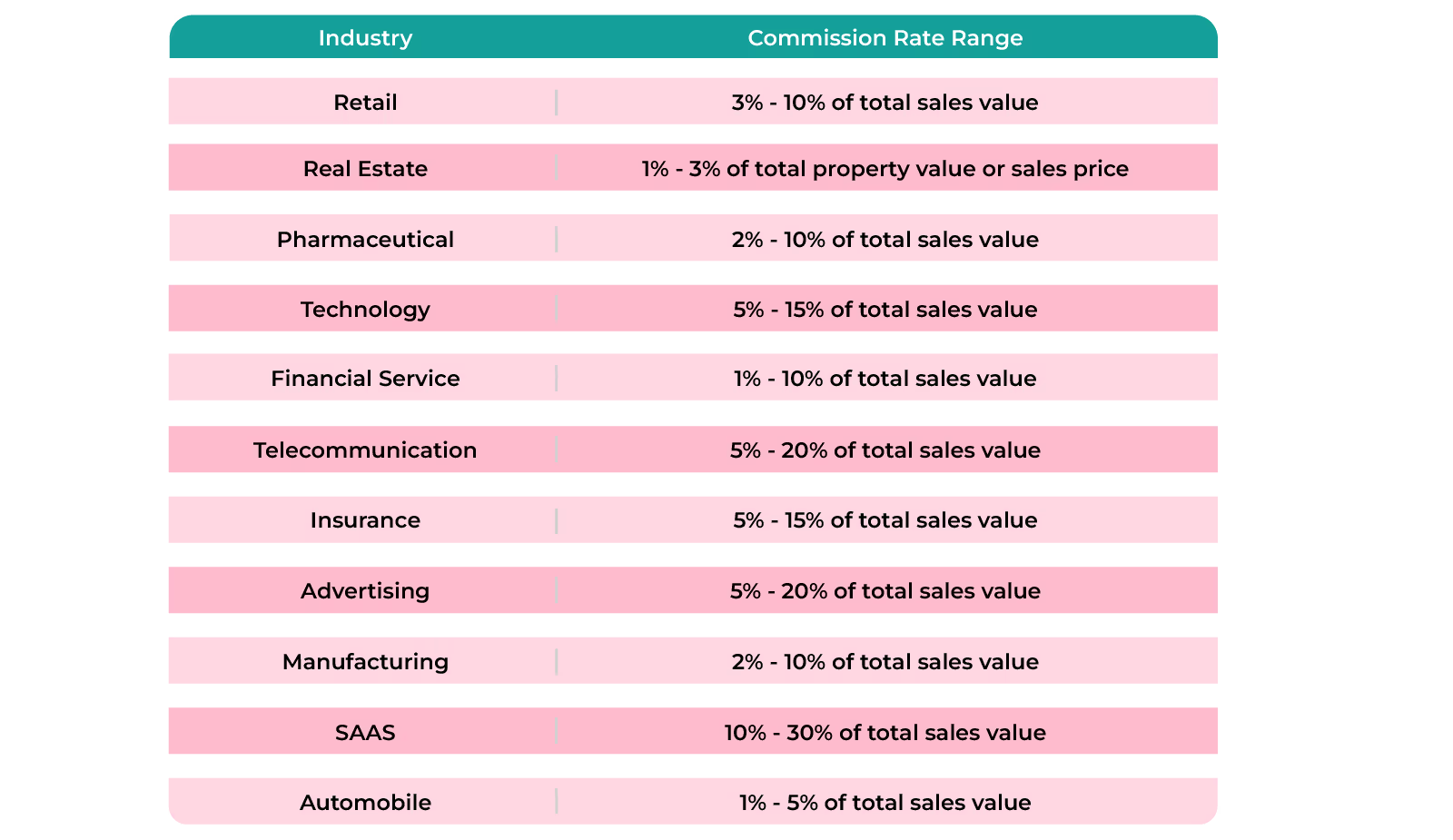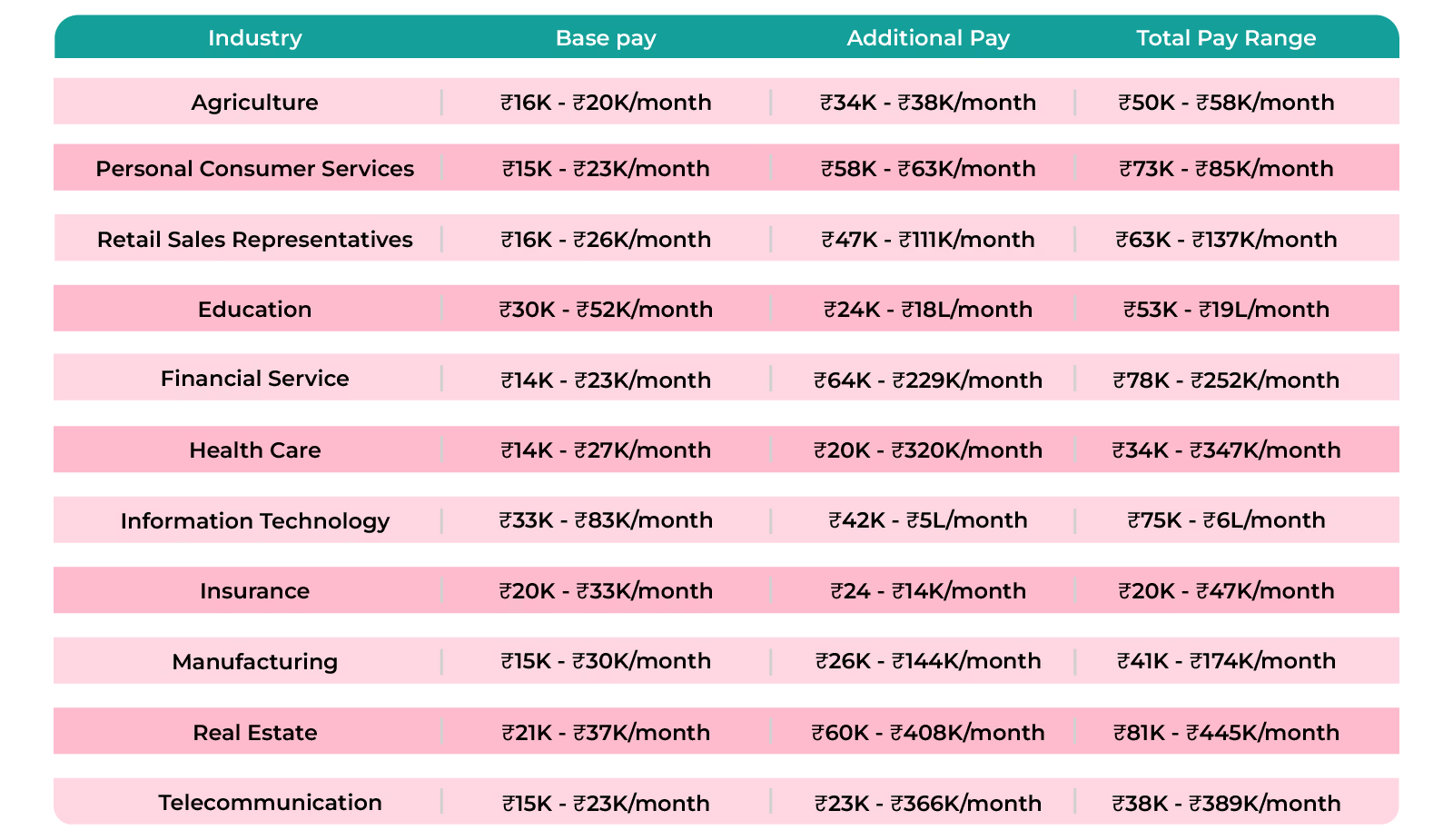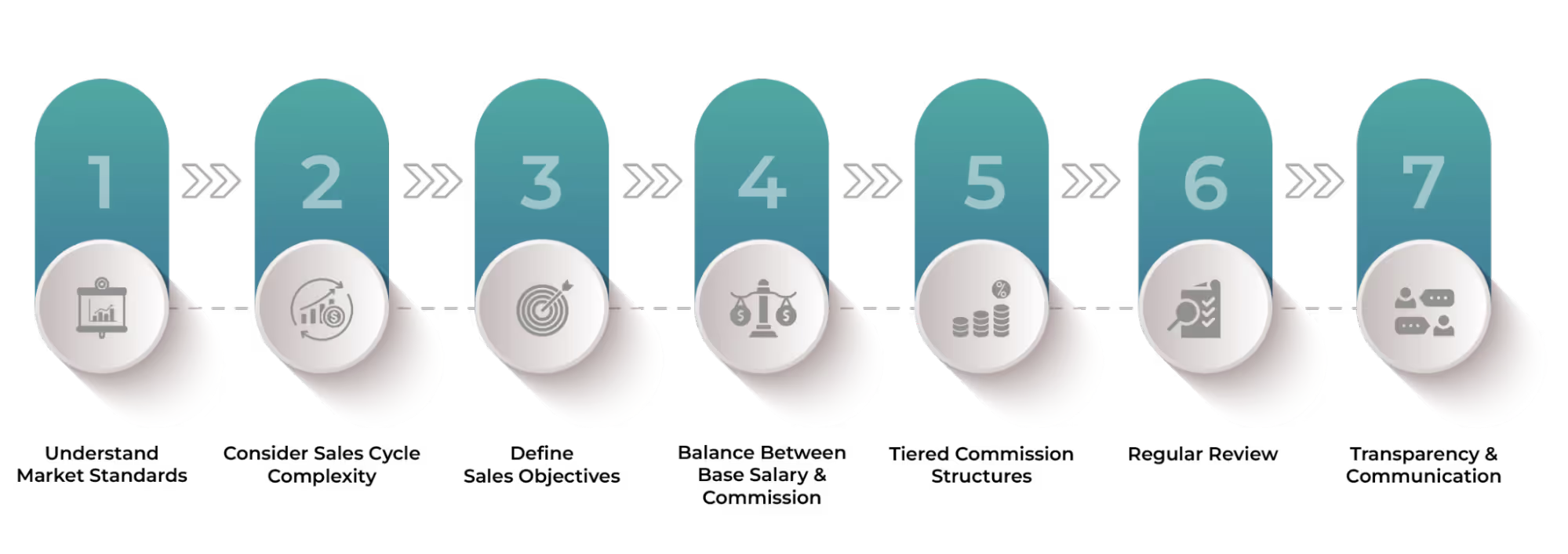
Blog
Sales Commission Rates: Industry Average Breakdown
March 21, 2024


Key Insights
Sales commission is a powerful motivational tool. It has proved its effectiveness ever since sales became a profession. From encouraging, motivating, and boosting overall sales performance it is an integral part of sales operations.
However, building a sales commission alone will not ensure effectiveness and competency from the salesforce. It requires ensuring that the sales reps are happy and satisfied with the way the commission is calculated and the portion of the revenue they earn.
In short, there needs to be more clarity on sales commission rates.
This article will give you a comprehensive understanding of sales commission rates, why deciding your sales commission rate is important, the average sales commission rates by industry, how much each sales rep earns, what is a good commission rate, how to design a competitive commission rate and examples of some of the most common sales commission structures that businesses make use of.
Scroll down for more reading.
What are Sales Commission Rates?
Sales commission rate refers to the commission percentage a sales rep will earn for generating sales. The rates are determined based on the sales reps’ experience, industry, market conditions type of product, market penetration, etc.
Sales commissions can range from 1% to 100% depending upon the commission structure. A sales rep with a salary plus commission structure has a fixed base salary that they will be paid irrespective of their sales. In addition, they will earn a 1-10% commission rate when they make a sale. On the other hand, a sales rep with a straight commission has a 100% commission rate where their entire pay is based on the sale they make.
What are Average Sales Commission Rates?
Average sales commission rates are dependent on several factors. This includes industry, types of sales roles, experience level, geographical level, product type, etc.
For example, the commission rate of a sales rep working in the real estate industry will earn 5-6% of the sale price, while a SaaS sales commission rate can go up to 20% of the sale price.
In addition, the commission rates of sales associates vs sales executives also vary as their roles, responsibilities, and experience vary.
Eventually, the average commission on sales is estimated based on individual circumstances, company agreements, and the relationship between the employer and employee.
Why Is Deciding The Sales Commission Rate Important?
Sales operations must consider deciding their sales commission rates as a crucial task. Let us look at some of the reasons why this decision is important:
- Commission rates have a direct impact on the incentives the sales reps earn and therefore affect their motivation levels as well. A higher commission rate means a higher incentive and better sales motivation and performance.
- Companies that offer higher commission rates will have better chances of attracting top talents to their organization and retaining their high-performing sales reps. Effective commission expense accounting is crucial for ensuring that these rates are sustainable and align with the company's financial goals.
- Salesperson commission rate must be set by taking into account the company’s budget availability, competitor standards, and market conditions. This allows you to offer a competent sales commission rate that retains your sales talents cost-effectively.
- Commission rates must be set fairly and equitably across the sales team. Differences and disparities can lead to conflicts among sales reps thus compromising the team coordination and impacting morale and unity.
- Sales commission rates but align with the company objectives. If the organizational targets are high and difficult to achieve, then commission rates must also be high and competent to boost their motivation and performance to ensure desired results.
Wish to know how an approach in sales process can guide your salesforce in achieving higher commission rates? Check Why Sales Approaches Are the Key to Your Business Success.
Average Sales Commission Rates by Industry
As mentioned above, determining a sales rep’s commission rate is based on individual factors and market conditions.
Market analysis shows the general range of a sales rep's commission rate by industry by considering factors like their experience, the sales cycle complexity, market penetration, the overall sales process, etc.

Though the commission percentage seems to vary depending on various industries, the ratio between the sales revenue generated and the commission rate will give a satisfactory incentive that ensures their consistent performance throughout the sales cycle and motivates them to strive for regular closing of deals.
How much do Sales Reps Make?
The earnings of sales reps are widely dependent on several factors. The industry they work in, their years of experience, sales role, responsibility and performance, the geographical location they handle, and the company size are some of the factors that influence their income. Commission-only sales reps, in particular, have a direct correlation between their efforts and earnings, making their income more variable and performance-driven.
In addition to these factors, the sales commission structure the company has adopted also influences how much a sales rep makes a month. For example, a sales rep with a base salary will earn a fixed amount irrespective of the sale they made that month. While a sales rep with a straight commission is dependent on the deals they close to ensure a stable income.
According to Glassdoor Salary Data, the base salary, variable pay, and the total pay range that a sales rep with 1-3 years of experience in India earns varies widely based on different industries.

*Statistics based on Glassdoor Salaries updated on 17th March 2024.
In most industries, the additional pay (incentives, bonuses, commissions, perks) is way higher than their base salary. For example, income earned in the agriculture and insurance industries are low when compared to the earnings of a sales rep in Education or IT. The balance between commission vs bonus can significantly impact the overall compensation structure, with some industries favoring one over the other based on performance metrics and business objectives.
Hence, the earnings of a sales rep vary based on individual factors, company landscape, and market conditions.
Enhance your sales understanding through examples of selling concepts in marketing. Check out the Advantages and Disadvantages of Sales Concepts.
What is a Good Commission Rate for Sales?
The ideal commission rate for a sales rep depends on their industry, product type, experience, overall commission structure, etc. Hence, a sales rep can earn from a range of 1%-30% of the sales revenue as commission for the sale they made.
For example, a real estate sales rep might have a 1% commission rate for each sale. However, a 1% commission for a 2 crore property will sum up to a huge amount. Here the factors that influence the commission rate are the sales volume and the complexity of the sale.
On the other hand, a sales rep in SaaS might get an average percentage sales commission of 30% for the sale they make. But with their recurring sale chances, the final commission earnings for the quarter will sum up to a large amount. Here, the sales commission rates are determined by the sales cycle length, sales volume, and the experience of the sales rep.
Hence, a typical sales commission percentage is a subjective metric that depends on the industry standards, profit margins, sales cycle length, sales volume, complexity of the sale, sales rep experience, etc.
Eventually, the objective of setting a good commission rate is that you pay a healthy amount to your sales rep to ensure they improve their performance, bring profitable sales, and drive consistent growth and revenue for the organization.
Tip: Include a non-recoverable draw to see the changes in your salesforce performance.
How to Design Competitive Commission Rates?
Designing a competitive commission rate involves taking into consideration several factors to ensure sales motivation while aligning with company objectives. Let's look into a step-by-step guide to building your competitive sales commission rate:

Understand Market Standards
Sales managers must research the market standards, and keep a close watch on what the competitors offer to ensure that your commission rates ensure sales performance, motivation, and competitiveness. Utilizing a comprehensive sales commission report can provide valuable insights into how well the current commission structure is performing and where adjustments may be needed to stay competitive.
Consider Sales Cycle Complexity
Sales cycle complexity must be taken into consideration while setting your commission rate. Companies with complex offerings will have a longer sales cycle and thus sales reps must be incentivized for their consistent time and effort invested during the long period to close the deal.
Define Sales Objectives
Sales objectives must be clearly defined to give clarity on the role and responsibilities expected from the sales rep. Commission rates must be structured to achieve these objectives like targeting customer segments, closing more deals, driving overall revenue growth, etc.
Balance Between Base Salary and Commission
Incentive programs must strike a balance between base salary and commission based on the company’s budget allocation and resource availability. Base salary will give financial stability to sales reps while the variable pay motivates them to boost performance.

Tiered Commission Structures
Implementing a tiered compensation structure encourages sales reps to perform beyond their expectations. The possibility of earning a higher commission rate each time you achieve a milestone will help in enhancing the overall sales performance and thereby sales revenue growth.
Regular Review
Designing a salesperson's commission rate is not a one-time process. It is a recurring process that needs regular monitoring to ensure effectiveness and updates based on changing market trends to ensure competitiveness and alignment with business growth.
Transparency and Communication
The effectiveness of sales commission is ensured only when it is clearly and transparently communicated with the sales reps. This includes discussing the particulars of commission percentage, calculation, eligibility criteria, payment, etc. Transparency fosters trust in sales reps which reflects in their efforts and achievements.
Designing competitive commission rates depends on what fits your company structure, its budget capacity, resource availability, and other operational factors to drive sales performance and growth.
Most Common Sales Commission Structures
There are several sales commission structures that companies can incorporate based on their budget, resources, and operational requirements. Here are some of the most common sales commission structures:

Straight Commission
In a straight commission plan, the sales reps’ income is solely based on their variable pay with no base salary. They earn a percentage of the revenue they generate as commission. Though the structure gives limitless possibilities on what a sales rep can earn, the absence of fixed pay can have backlash during market downturns.
Salary Plus Commission
Most sales reps prefer a salary plus commission structure where their total pay is a combination of their base salary and the variable pay. The base salary provides financial stability to sales reps as it is paid irrespective of the sales they make. The variable pay motivated the salesforce to improve their performance, drive more sales, and enhance their total income.
Tiered Commission
In a tiered commission structure, the sales reps have the opportunity to earn a higher commission rate when they exceed their set sales target. For example, a sales rep with a 5% commission rate can earn an 8% commission when they exceed their target of $10,000. This motivates the salesforce to exceed their expectations and drive more sales and revenue.
Profit-Based Commission
Profit-based commission calculates commission based on the profit margin made rather than the revenue generated. This profit margin can be calculated as a percentage of the profit of a single sale or the cumulative profit made by all the sales generated by the sales rep.
Residual Commission
Residual commissions are common in insurance and subscription-based businesses where there is recurring revenue generation. Sales resp thus get paid not just for the initial sale but also for the recurring revenue generated from subscriptions. Hence, sales reps are not just responsible for customer acquisitions but must maintain healthy relationships to ensure customer retention as well.
Team-Based Commission
Team-based commission pays sales reps not for their individual achievements but for the collective performance of their team. Incorporating such a commission structure will therefore ensure teamwork and collaboration while closing a deal.
Bonus and Incentive Programs
Bonuses and incentives are exceptional rewards given to sales reps for achieving short-term goals, showcasing exceptional performance, or achieving sales during a period. This can include cash bonuses, free vacations, and paid time off that will ensure continued and consistent performance from sales reps.
Selecting the most appropriate sales commission structure depends on the company culture, sales objectives, employee needs, and preferences, budget availability, etc. Most companies do not just make use of one commission structure but tailor their program through a combination of two or more commission structures for better results and growth, especially in industries like SaaS sales compensation, where subscription-based models and recurring revenue play significant roles.
Final Thought
Determining your sales commission rates is an integral part of building a clear, transparent, and competitive sales compensation program. Your salesforce deserves a healthy and competitive commission rate to encourage them to boost their sales performance and drive revenue growth and success.
However, what is a healthy and competent commission rate is unique to each industry and its market trends. External factors like industry trends, market conditions, competitor standards, the complexity of the sales, etc can influence the determination of your commission rate.
In addition, other factors like the sales rep’s experience, role, responsibilities, potential, and skill are also decisive in striking an agreement between the employer and employee on the commissions and incentives.
Whatever these decisive factors, businesses must ensure that their commission rates meet the employee needs and ensure their satisfaction to motivate them to improve their performance, enhance their sales, optimize their strategies, and thereby positively impact the overall sales operations.
Beyond the money and numbers, the positive impact it creates is the determining factor in checking the effectiveness of your sales commission rates and structures.
To read more about SaaS sales commission structure and sales incentive-related topics, visit https://www.kennect.io/. For more information on incentive automation and sales performance management, Book A Demo with us.
ReKennect : Stay ahead of the curve!
Subscribe to our bi-weekly newsletter packed with latest trends and insights on incentives.
Thank you! Your submission has been received!
Oops! Something went wrong while submitting the form.
Your data is in safe hands. Check out our Privacy policy for more info















